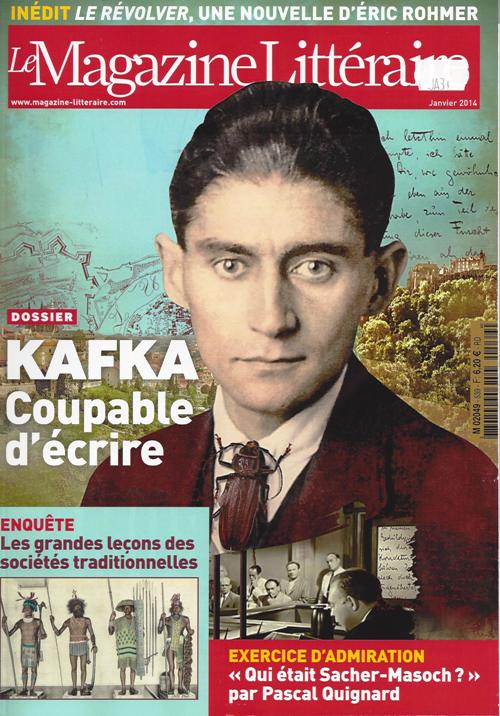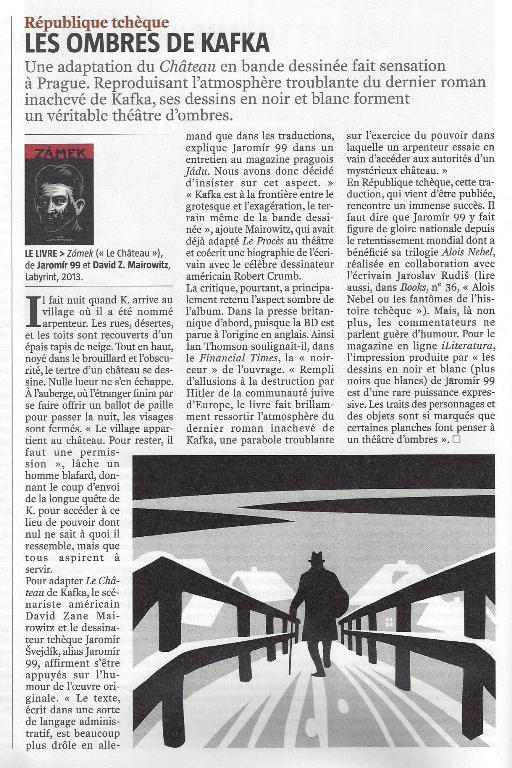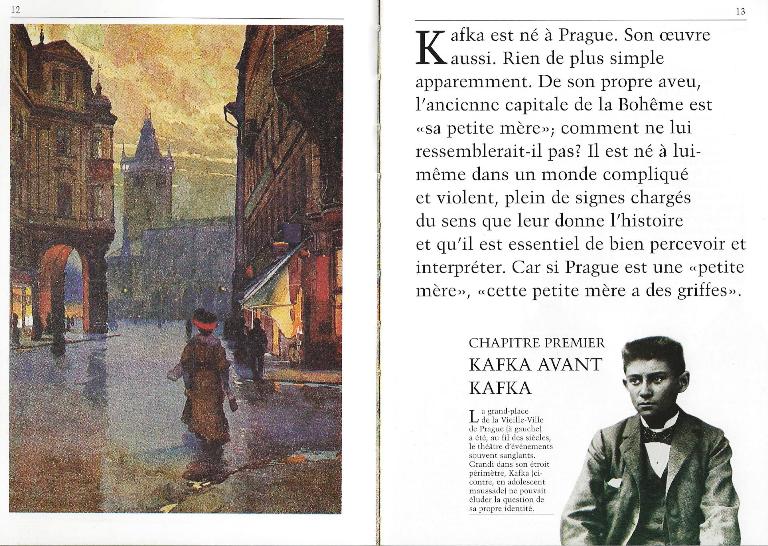 Prague của
Kafka
|
Kafka's
Prague Prague isn't willing to
leave nor
will it let us leave. This girl has claws and people must line up or we
will
have to light a fire at Vysehrad and the Old Town Square before we can
possibly
depart. -Excerpt from a letter from Kafka to Oskar Pollak Xề Gòn đếch
muốn bỏ đi, mà cũng đếch muốn GCC bỏ đi. Trong bài viết
của Bei Dao, trên, có nhắc tới cuốn sau đây.
Kafka,
hàng độc "Kafka
was Prague and Prague was Kafka.
It had never been so completely and so typically Prague, nor would it
ever again
be so as it was during Kafka's lifetime. And we, his friends ... knew
that this
Prague permeated all of Kafka's writings in the most refined miniscule
quantities." From an intimacy with a common spiritual homeland shared
with
Kafka, Professor Johannes Urzidil conjures up the essential background
of the
poet and provides authentic emphases for the understanding of his
literary art.
Personal experiences and recollections, wide reading, penetrating
insight, and
love congeal in Urzidil into an authentic and convincing interpretation
of the
living atmosphere surrounding Kafka and of his prime literary motifs
and ideas.
This edition, like that of the Deutsche Taschenbuch Verlag, has been
enlarged
so as to include five hitherto unpublished chapters, viz., impressive
portraits
of people close to Kafka, commentaries on Kafka's relation to the
visual arts,
on the history and impact of the Colem myths, on Kafka's intent at one
time to
destroy his manuscripts, as well as Urzidil's speech at the
commemorative
observance in 1924 in the Little Theater in Prague shortly after
Kafka's death. Professor Johannes Urzidil
was born in 1896 in Prague. After completing his philosophical
studies there, he became one of the younger poets of the German
expressionist movement
and was in close contact with the Prague Literary Circle of Brod,
Kafka, Werfel,
and others. In 1939 he emigrated to the United States via Italy and
England and
settled in New York, where he is still living. His first publication
was a
volume of expressionistic poems (1919). Professor Urzidil has published
seven
volumes of stories and novels and is the author of many essays and
treatises.
Among his better known and more important scholarly works are Goethe in
Bohmen
(Goethe in Bohemia), 1962; Goethes Amerikabild (Goethe's Image of
America),
1958; and Amerika und die Antike (America and Ancient Antiquity)1964.
He was
awarded the Swiss International Prix Veillon for the best German novel
(1957),
the literary prize of the City of Cologne (1964), the Great Austrian
State Prize
for Literature (1964), and the Andreas Gryphius Prize (1966). He is a
corresponding
member of the German Academy of Language and Poetry in Darmstadt, of
the Austrian
Adalbert Stifter Institute and of several other learned and literary
societies.
Works of Johannes Urzidil have been translated from the German
originals into
English, French, Italian, Czech, Dutch, Hungarian, Russian, and Spanish. jacket design by S. R. Tenenbaum
Sài Gòn là Gấu,
và Gấu là Sài Gòn. Sài Gòn sẽ chẳng bao giờ hoàn tất đến như thế, đặc
biệt Sài
Gòn đến như vậy, và nó sẽ chẳng bao giờ lại như vậy, như trong đời của
Gấu,
khi ở Sài Gòn! Cái “Sài Gòn
là Gấu và Gấu là Sài Gòn”, áp dụng chung cho tất cả chúng ta, Miền Nam,
và nó là 1
chân lý, bị cố tình hiểu lầm ra là, toan tính phục hồi cái xác chết
VNCH. Cái "gì gì" lịch sử có thể viết lại nhưng không thể làm lại! [Châm ngôn lừng danh của SCN] (1)
A Different
Kafka
Note: Tay này, John
Banville , nhà
văn số 1, phê bình, điểm sách cũng số 1.
Thử đếm coi,
Thầy Kuốc điểm sách của ai, khui ra được nhà văn nào. Mũi lõ cũng
không, mà mũi
tẹt lại càng không? GCC ư? Nhiều
lắm. Bảo Ninh, thí dụ, Gấu phát
giác ra, ở hải ngoại, và cái ông BN mà
Gấu viết,
cũng khác ông ở trong nước. Miêng, Mai Ninh, Trần
Thanh Hà, Trần Thị NgH... Gấu đều trân trọng viết
về họ.
Of course,
Kafka is not the first writer, nor will he be the last, to figure
himself as a
martyr to his art—think of Flaubert, think of Joyce—but he is
remarkable for
the single-mindedness with which he conceived of his role. Who else
could have
invented the torture machine at the center of his frightful story “In
the Penal
Colony,” which executes miscreants by graving their sentence—le
mot juste!—with a metal stylus into
their very flesh? Lẽ dĩ nhiên,
Kafka đâu phải nhà văn đầu tiên, càng không phải nhà văn cuối cùng,
nhìn ra
mình, lọc mình ra, như là 1 kẻ tuẫn nạn, vì cái thứ nghệ thuật mà mình
chọn lựa
cho mình: “dziếc dzăng”! “Kim chích vô
thịt thì đau” là theo nghĩa này đấy! [Note: Trang TV này cũng đang hot, nhờ vậy mà GCC mới biết đến nó]
Primo Levi
phán, tớ là 1 nhà hóa học, tớ quan sát, để hiểu, nhưng hiểu không có
nghĩa là
tha thứ, bởi là vì tha thứ là hành động chỉ có những người có niềm tin
tôn
giáo, làm được. Một tên vô thần như tớ, thua! "Comprendre,
ce n’est pas pardoner". Le pardon est un acte religieux don’t il est,
lui
l’athée, incapable. Trong số báo mới nhất về Kafka, có hai bài, lạ, một, về Kertesz và mối nối giữa ông và Kafka, và một, về Primo Levi, đúng hơn, về 1 cuộc trò chuyện của ông, Vùng Xám, La Zone Grise, mới ra lò. Bài “Ba cái nhìn để biến Kafka thành 1 kẻ vô xứ” [từ này Gấu chôm của Thầy Đạo], “Trois regards pour dépayser Kafka”, trong ba cái nhìn này, thì cái nhìn biến Kafka thành nhà thơ của sự tủi hổ và phạm tội, khủng nhất.
Kafka đi vô truyền thuyết
"Sát Thủ Đầu Mưng Mủ"!
[Books, Janvier, 2014]
Dịch lại & Lại dịch
"Hóa Thân" của Kafka qua tiếng Anh JANUARY
15, 2014 ON
TRANSLATING KAFKA’S “THE METAMORPHOSIS” POSTED
BY SUSAN BERNOFSKY This essay is adapted from the afterword to the author’s new translation of “The Metamorphosis,” by Franz Kafka. Cú
khó sau chót, về dịch, là cái từ trong cái tít. Không
giống từ tiếng Anh, “metamorphosis,”
“hóa
thân”, từ tiếng Đức
Verwandlung
không đề nghị cách hiểu tự nhiên, tằm
nhả tơ xong, chui vô kén, biến thành nhộng, nhộng biến thành
bướm, trong vương quốc loài vật. Thay vì
vậy, đây là 1 từ, từ chuyện thần tiên, dùng để tả sự chuyển hóa, thí dụ
như
trong chuyện cổ tích về 1 cô gái đành phải giả câm để cứu mấy người
anh bị bà phù thuỷ biến thành vịt, mà Simone Weil đã từng đi 1 đường
chú giải
tuyệt vời. Hà,
hà! One
last translation problem in the story is the
title itself. Unlike the English “metamorphosis,” the German word Verwandlung
does not suggest a natural change of state associated
with the animal
kingdom such as the change from caterpillar to butterfly. Instead it is
a word
from fairy tales used to describe the transformation, say, of a girl’s
seven
brothers into swans. But the word “metamorphosis” refers to this, too;
its
first definition in the Oxford English Dictionary is “The action or
process of
changing in form, shape, or substance; esp. transformation by
supernatural
means.” This is the sense in which it’s used, for instance, in
translations of
Ovid. As a title for this rich, complex story, it strikes me as the
most
luminous, suggestive choice.
|



